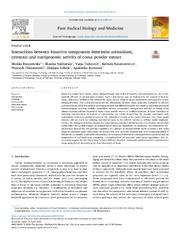Приказ основних података о документу
Interactions between bioactive components determine antioxidant, cytotoxic and nutrigenomic activity of cocoa powder extract
| dc.creator | Baranowska, Monika | |
| dc.creator | Suliborska, Klaudia | |
| dc.creator | Todorović, Vanja | |
| dc.creator | Kusznierewicz, Barbara | |
| dc.creator | Chrzanowski, Wojciech | |
| dc.creator | Šobajić, Slađana | |
| dc.creator | Bartoszek, Agnieszka | |
| dc.date.accessioned | 2020-06-01T11:44:34Z | |
| dc.date.available | 2020-06-01T11:44:34Z | |
| dc.date.issued | 2020 | |
| dc.identifier.issn | 0891-5849 | |
| dc.identifier.uri | https://farfar.pharmacy.bg.ac.rs/handle/123456789/3584 | |
| dc.description.abstract | Numerous studies have shown, rather disappointingly, that isolated bioactive phytochemicals are not as biologically effective as natural plant products. Such a discrepancy may be explained by the concept of food synergy, which was verified in this research for cocoa extract versus its major components with regard to cancer chemoprevention. The evaluation embraced the relationship between redox properties evaluated in cell-free systems with the aid of free radicals scavenging method and differential pulse voltammetry, and redox associated anticarcinogenic activities (cellular antioxidant activity, cytotoxicity, nutrigenomic activity) in human colon adenocarcinoma cell line exposed to either cocoa powder extract or artificial mixtures of cocoa bioactives at matching concentrations. In contrast to expectations, our results showed that the stepwise enrichment with antioxidants caused no gradual increase in the antioxidant activity of the model mixtures; also, these model mixtures did not reach the reducing potential of cocoa in the cell-free systems or cellular model employed. Further, the biological activities examined in colon adenocarcinoma cells did not alter in a stepwise manner that could reflect the gradual changes in composition of bioactive ingredients. In conclusion, the experiments presented here showed that the growing complexity of a mixture of phytochemicals seems to create a new redox bioactive substance rather than enrich the mixture with new activities, characteristic of the compound added. It follows that no simple, predictable relationship can be expected between the chemopreventive potential and the composition of real food items containing a complicated set of non-toxic redox active ingredients. Our observations suggest that the interactions between different bioactive compounds and food matrix components are cooperating factors determining the final bioactivity of foods. | en |
| dc.publisher | Elsevier | |
| dc.relation | National Science Centre (Poland) through the MAESTRO 6 grant programme (application number 2014/ 14/A/ST4/00640) | |
| dc.relation | COST Action CA16112 supported by COST (European Cooperation in Science and Technology) | |
| dc.rights | openAccess | |
| dc.rights.uri | https://creativecommons.org/licenses/by/4.0/ | |
| dc.source | Free Radical Biology and Medicine | |
| dc.subject | Antioxidants | |
| dc.subject | Catechins | |
| dc.subject | Chemoprevention | |
| dc.subject | Cocoa powder | |
| dc.subject | Food synergy | |
| dc.subject | Redox biology | |
| dc.title | Interactions between bioactive components determine antioxidant, cytotoxic and nutrigenomic activity of cocoa powder extract | en |
| dc.type | article | |
| dc.rights.license | BY | |
| dcterms.abstract | Бартосзек, Aгниесзка; Тодоровић, Вања; Шобајић, Слађана; Бараноwска, Моника; Сулиборска, Клаудиа; Кусзниереwицз, Барбара; Цхрзаноwски, Wојциецх; | |
| dc.citation.volume | 154 | |
| dc.citation.spage | 48 | |
| dc.citation.epage | 61 | |
| dc.citation.rank | M21 | |
| dc.identifier.wos | 000537132500005 | |
| dc.identifier.doi | 10.1016/j.freeradbiomed.2020.04.022 | |
| dc.identifier.scopus | 2-s2.0-85084365695 | |
| dc.identifier.fulltext | https://farfar.pharmacy.bg.ac.rs/bitstream/id/7702/Interactions_between_bioactive_pub_2020.pdf | |
| dc.type.version | publishedVersion |

